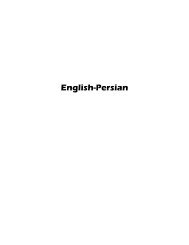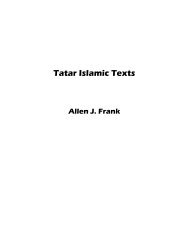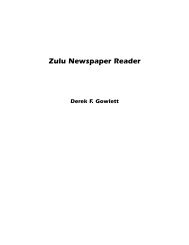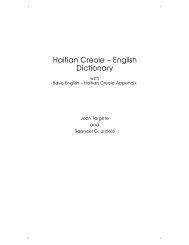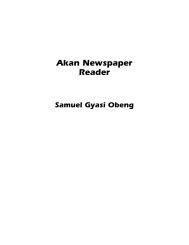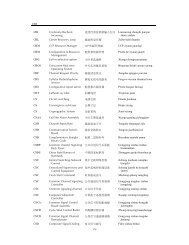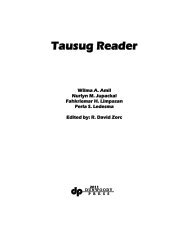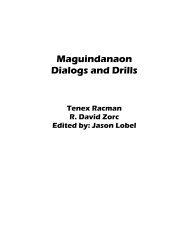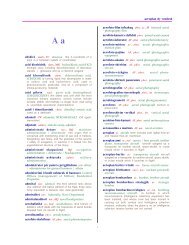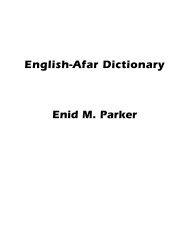Maguindanao Grammar Supplement 1994 - Dunwoody Press
Maguindanao Grammar Supplement 1994 - Dunwoody Press
Maguindanao Grammar Supplement 1994 - Dunwoody Press
You also want an ePaper? Increase the reach of your titles
YUMPU automatically turns print PDFs into web optimized ePapers that Google loves.
<strong>Maguindanao</strong><br />
<strong>Grammar</strong> <strong>Supplement</strong><br />
Ruth Stickney
<strong>Maguindanao</strong><br />
<strong>Grammar</strong> <strong>Supplement</strong><br />
Ruth Stickney<br />
<br />
2009
<strong>Maguindanao</strong> <strong>Grammar</strong> <strong>Supplement</strong><br />
Copyright © 2009 by McNeil Technologies, Inc.<br />
All rights reserved.<br />
No part of this work may be reproduced or transmitted in any form or by any<br />
means, electronic or mechanical, including photocopying and recording, or by any<br />
information storage and retrieval system, without prior written permission from the<br />
copyright owner.<br />
All inquiries should be directed to:<br />
<strong>Dunwoody</strong> <strong>Press</strong><br />
6525 Belcrest Rd., Suite 460<br />
Hyattsville, MD 20782, U.S.A.<br />
ISBN: 978-1-931546-61-4<br />
Library of Congress Control Number: 2009927158<br />
Printed and bound in the United States of America
Table of Contents<br />
Publisher’s Preface ............................................................................. i<br />
Preface ........................................................................................... ii<br />
References ...................................................................................... iii<br />
Abbreviations ................................................................................... iv<br />
Lesson 1: <strong>Maguindanao</strong> Clause – Basic ......................................... 1<br />
Lesson 2: Class System .................................................................. 3<br />
Lesson 3: <strong>Maguindanao</strong> Clause – Non-Basic ............................... 11<br />
Lesson 4: Question Words ........................................................... 13<br />
Lesson 5: Interrelationship of Nouns, Adjectives, and Verbs ...... 18<br />
Lesson 6: Kinds of Prepositional Phrases .................................... 20<br />
Lesson 7: Linkers and Modifiers .................................................. 22<br />
Lesson 8: Possessive Phrase ......................................................... 26<br />
Lesson 9: Rules for Sentence Structure ........................................ 27<br />
Lesson 10: Non-verbal Clauses ...................................................... 37<br />
Lesson 11: Pseudo Verbs and their Clauses ................................... 42<br />
Lesson 12: Verbal Clauses ............................................................. 45<br />
Lesson 13: Object Focus or Passive Conjugation<br />
of UM Verbs -IN- ........................................................ 50<br />
Lesson 14: Abilitative .................................................................... 57<br />
Lesson 15: Causative ...................................................................... 59<br />
Lesson 16: Abilitative Causative .................................................... 62<br />
Lesson 17: Object Focus or Passive Conjugation of<br />
PAG- Verbs -IN- .......................................................... 63<br />
Lesson 18: Object Focus or Passive Conjugation of<br />
PANG- Verbs -IN- ....................................................... 66<br />
Lesson 19: Verb Categories ........................................................... 69<br />
Lesson 20: Agent Focus or Active Conjugation of -UM- Verbs .... 74<br />
Lesson 21: Agent Focus or Active Conjugation OF<br />
PAG- Verbs .................................................................. 77<br />
Lesson 22: Agent Focus or Active Conjugation OF<br />
PANG- Verbs ............................................................... 80
Lesson 23: Helping Verb Clause .................................................... 84<br />
Lesson 24: Plurals .......................................................................... 91<br />
Lesson 25: Comparison .................................................................. 93<br />
Lesson 26: Location Focus or Beneficiary Conjugation of<br />
UM verbs - AN ............................................................ 96<br />
Lesson 27: Location Focus or Beneficiary Conjugation of<br />
PAG- Verbs - AN ........................................................ 99<br />
Lesson 28: Location Focus or Beneficiary Conjugation of<br />
PANG Verbs - AN ..................................................... 102<br />
Lesson 29: Noun Formers ............................................................ 105<br />
Lesson 30: Adjective Formers ...................................................... 108<br />
Lesson 31: Instrument Focus or Reason Conjugation of<br />
UM Verbs – I- ............................................................ 110<br />
Lesson 32: Instrument Focus or Reason Conjugation of<br />
PAG Verbs – I- .......................................................... 113<br />
Lesson 33: Instrument Focus or Reason Conjugation of<br />
PANG Verbs - I ......................................................... 116<br />
Lesson 34: Recent Action and Future Action .............................. 119<br />
Lesson 35: Past Time Phrases and Constructions ........................ 120<br />
Lesson 36: Indefinite Time Phrases and Constructions ............... 123<br />
Lesson 37: Future Time Phrases and Constructions..................... 125<br />
Lesson 38: Expressing Emotions ................................................. 126<br />
Lesson 39: Commands ................................................................. 129<br />
Lesson 40: Negatives ................................................................... 132<br />
Lesson 41: Habitual and Social Action ........................................ 135<br />
Lesson 42: Low Concentration, Reciprocal, and Unintentional<br />
Action ......................................................................... 137<br />
Lesson 43: Derivational Affixes................................................... 139<br />
Appendices<br />
Appendix A .................................................................................... 131<br />
Appendix B ..................................................................................... 135<br />
Appendix C ..................................................................................... 136
Publisher's Preface<br />
<strong>Dunwoody</strong> <strong>Press</strong> is pleased to issue Ruth Stickney’s <strong>Maguindanao</strong><br />
<strong>Grammar</strong> <strong>Supplement</strong>. Ms. Stickney adapted the grammar from the<br />
OMF Tagalog <strong>Grammar</strong> <strong>Supplement</strong> (1987) with the permission of K.<br />
Lampinen, Language Coordinator. The <strong>Press</strong> thanks OMF International<br />
for granting permission to revise and republish Ms. Stickney’s work.<br />
The revision of the text was undertaken by Dr. R. David Zorc, with<br />
the final text approved by Ms. Stickney. Of Dr. Zorc’s work Ms.<br />
Stickney wrote “I am indebted to Dr. R. David Zorc for his<br />
masterful reworking of the original to produce this second edition<br />
containing corrections, notes, and a list of references.” We heartily<br />
agree with Ms. Stickney’s remarks.<br />
<strong>Maguindanao</strong> <strong>Grammar</strong> <strong>Supplement</strong> is the first in a series of<br />
training materials <strong>Dunwoody</strong> <strong>Press</strong> is preparing on <strong>Maguindanao</strong>.<br />
<strong>Maguindanao</strong> Dialogs and Drills will be published shortly, and a<br />
<strong>Maguindanao</strong>n reader is in the planning stages.<br />
The Publisher<br />
i
Preface<br />
I wish to thank all those who in some way have had a part in the<br />
preparation of this <strong>Supplement</strong>. Especially I wish to thank my<br />
husband - for his ceaseless encouragement, his practical advice, and<br />
for his untiring devotion to the <strong>Maguindanao</strong> people; and our<br />
children - for their understanding and acceptance. Most of all I thank<br />
our Heavenly Father Who gave the strength and insight.<br />
Sources include Ron Moe (1988) – “<strong>Maguindanao</strong>n Particles,” and<br />
Eric Fleishman (1880) - “<strong>Maguindanao</strong>n Verbal Inflections.”<br />
However, I assume responsibility for any and all errors. This is not a<br />
definitive linguistic analysis of the language, but rather a tool to assist<br />
those wishing to study the <strong>Maguindanao</strong> language.<br />
For this second edition, I would like to thank Bruce van Zante, Sarah<br />
Goodman, John Ulrich Wolff (Professor Emeritus, Cornell<br />
University), and Dr. R. David Zorc for their many astute comments<br />
and suggestions for improvement. Finally, thanks to Julie Cruz for<br />
formatting the text for publication.<br />
ii<br />
Ruth Stickney
References<br />
Afdal, Eden G. 1965. “A Descriptive-Contrastive Analysis of<br />
English and <strong>Maguindanao</strong> Consonants and Vowels.”<br />
Unpublished seminar paper, UP. 75 lvs.<br />
Albas, Pablo Y. 1964. A contrastive analysis of English and<br />
Magindanao verbs. Unpublished MA thesis, CPU.<br />
Allison, E. Joseph. 1974. Proto-Danao: A comparative study of<br />
Maranao, Magindanao, and Iranon. Unpublished MA thesis,<br />
University of Texas, Arlington.<br />
–1979. “Proto-Danaw: A comparative study of Maranaw,<br />
Magindanaw, and Iranun,” Papers in Philippine Linguistics,<br />
No. 10. Pacific Linguistics A.55:53-112. Canberra: The<br />
Australian National University. (Published version of 1974<br />
thesis)<br />
Anonymous. 1887. Cartilla Moro-Castellana para los<br />
<strong>Maguindanao</strong>s. Manila: Imprenta y Litografia de M. Perez.<br />
55 pp.<br />
Anonymous. 1888. Compendio de Historia Universal desde la<br />
Creacion del mundo rasta la Venida de Jesuscristo. Y un<br />
Breve Vocabulario en Castellano y en Moro-<strong>Maguindanao</strong>.<br />
Singapore: Imprenta de Koh Yew Hean. vi +146 pp.<br />
Blumentritt, Ferdinand. 1891. “Die <strong>Maguindanao</strong>s.” Aus 64:886-<br />
892.<br />
–1893. Katechismus der Katholischen Glaubenslehre in der<br />
Ilongoten-Sprache Verfasst von P. Fray Francisco de la<br />
Zarza in Druck Gelegt und mit Aequivalenten des Ilongot-<br />
Textes in Spanischer, Beziehungsweise Tagalisher und<br />
Maguindanauischer Sprache. Wien. 30 pp.<br />
Eck, Jerome (Jerry). 1972. “Sketch of Magindanao phonology.”<br />
Nasuli, Malaybalay, Bukidnon: SIL. 45 lvs. (Unpublished<br />
manuscript)<br />
–1974. “Magindanao penultimate vowels.” Work Papers of the<br />
Summer Institute of Linguistics, University of North Dakota<br />
18: 125-31.<br />
Fleischman, Eric, Nasrullah Glang, Makakena Solaiman, Hadji<br />
Abdullah Ayub, and Faisal Daud, comps. 1981. Vocabulary:<br />
Magindanawn-Pilipino-English. Manila: SIL. 340 pp.<br />
Fleischman, Eric. 1980. “Magindanaon verbal inflection.” Nasuli,<br />
Malaybalay, Bukidnon: SIL. 21 lvs. (Manuscript, published<br />
in 1986, q.v.)<br />
iii
–1980. “Phonemics and morphophonemics of <strong>Maguindanao</strong>.”<br />
Nasuli, Malaybalay, Bukidnon: SIL. 19 lvs. (Unpublished<br />
manuscript)<br />
–1981. “The decline of datuship in the Iranun sultanate of Linek.”<br />
Dansalan Quarterly 2(4): 228-36.<br />
–1981. “The Danao languages: Magindanao, Iranun, Maranao, and<br />
Illanun.” Philippine Journal of Linguistics 12.1:57-77.<br />
–1986. “The <strong>Maguindanao</strong>n alphabet,” in Robert E. Sullivan (ed.), A<br />
<strong>Maguindanao</strong>n dictionary, 10. Cotabato City: Notre Dame<br />
University.<br />
–1986. “<strong>Maguindanao</strong>n verbal inflection,” in Robert E. Sullivan<br />
(ed.), A <strong>Maguindanao</strong>n dictionary, 26-45. Cotabato City:<br />
Notre Dame University.<br />
Forrest, Thomas. 1779. “Vocabulary of the <strong>Maguindanao</strong> tongue.”<br />
In A Voyage to New Guinea and the Moluccas, 415-442.<br />
Dublin: np. (Other editions, 1780. London: J. Robson;<br />
French translation, 1780; German translation, 1782).<br />
Juanmarti, Jacinto, SJ. 1888. Compendio de Historia Universal<br />
Desde la Creacion del Mundo Hasta la Venida de Jesucristo<br />
(y un breve vocabulario en Castellano y en Moro-<br />
<strong>Maguindanao</strong> por un padre missionero de la Compania de<br />
Jesus). Singapore: Imprenta de Koh Yew Hean. 146 pp.<br />
–1892. Gramatica de la Lengua de <strong>Maguindanao</strong> Segun se Habla en<br />
el Centro y en la Costa Sur de la Isla de Mindanao. Manila:<br />
Imprenta Amigos del Pais. 110+2 pp.<br />
–1892/1893. Diccionario Moro-<strong>Maguindanao</strong>-Español y Diccionario<br />
Español-Moro-<strong>Maguindanao</strong>. Manila: Tipografía Amigos<br />
del País. 242+270 pp. (2 parts in 1 vol)<br />
–1906. A <strong>Grammar</strong> of the <strong>Maguindanao</strong> Tongue (According to the<br />
Manner of Speaking It in the Interior and on the South Coast<br />
of the Island of Mindanao). Washington, DC: US<br />
Government Printing Office. 80 pp. (Translated by C. C.<br />
Smith from Spanish in 1892).<br />
Lee, Ernest W. 1962. “On non-syllabic high vocoids in<br />
<strong>Maguindanao</strong>.” Studies in Linguistics 16(3-4):65-72.<br />
–1964. “<strong>Maguindanao</strong> /l/.” General Linguistics 6(1):24-26.<br />
–1964. “Non-focus verbs in <strong>Maguindanao</strong>.” Oceanic Linguistics<br />
3(1):49-57.<br />
Maceda, Jose Montserrat. 1963. The Music of the Magindanao in the<br />
Philippines. Unpublished PhD dissertation, UCLA. 2 vols.<br />
iv
Moe, Ronald. 1986. “How to find verb roots,” in Robert E. Sullivan<br />
(ed.), A Magindanaon dictionary, 46-49. Cotabato City:<br />
Notre Dame University.<br />
–1988. “<strong>Maguindanao</strong>n particles.” Unpublished manuscript. 3 lvs.<br />
Porter, Ralph Stribling. 1903. A Primer and Vocabulary of the Moro<br />
Dialect (Magindanao). Washington, DC: US Government<br />
Printing Office. 77 pp. (Bureau of Insular Affairs, War<br />
Department Pamphlet 209).<br />
Smith, Cap Cornelius C. 1906. “A grammar of the Magindanao<br />
tongue,” in Gramatica de la Lengua de <strong>Maguindanao</strong> Segun<br />
se Habla en el Centro y en la Costa Sur de la Isla de<br />
Mindanao, by Jacinto Juanmarti. Washington, DC: US<br />
Government Printing Office.<br />
Sullivan, Robert E. (ed) 1986. <strong>Maguindanao</strong>n-English Dictionary.<br />
Cotabato City: Notre Dame University. 545 pp.<br />
Wein, Fr. Clemente, SVD. 1986. “An alternative classification of<br />
<strong>Maguindanao</strong>n conjugation,” in Robert E. Sullivan (ed.), A<br />
Magindanaon dictionary, 50-53. Cotabato City: Notre Dame<br />
University.<br />
Yamada. 1964-1975. “Unpublished MS of 513-item vocabulary<br />
((1962) Tsuchida)) of Isnag (2 dialects), Ibanag (2 dialects),<br />
Kalinga (2 dialects), Gaddang, Ilokano, Kapampangan, Bikol<br />
(2 dialects), Koyonen, Aklanon (2 dialects), Ilonggo (2<br />
dialects), Kinaray-a, Waray, Maranaw, Magindanaw,<br />
Manobo (Tagabawa), Tausug, and Samal.” Np.<br />
v
Abbreviations<br />
I Class I pronoun<br />
II Class II pronoun<br />
III Class III pronoun<br />
IV Class IV pronoun<br />
ABIL Abilitative Mode<br />
abr abbreviated; an abbreviation<br />
AF Agent or Actor Focus (focuses on the doer or<br />
instigator of the action)<br />
AGT Agent Participant Role (the doer or actor)<br />
BEN Beneficiary Participant Role<br />
BF Beneficiary Focus<br />
(c) Comment<br />
CAUS Causative Mode<br />
CCV syllable pattern Consonant + Consonant + Vowel<br />
COMP Completed Aspect (e.g., past)<br />
CONT Contemplated Aspect (e.g., future)<br />
deic demonstrative pronoun or deictic<br />
dp discourse particle<br />
EMS English-<strong>Maguindanao</strong>n Dictionary, Sullivan. 1986<br />
ex: example; for example<br />
GEN General Mode<br />
IF Instrument Focus<br />
INC Incompleted Aspect (e.g., present)<br />
INS Instrument Participant Role (the thing used to perform<br />
the action)<br />
LF Location Focus<br />
LOC Locative Participant Role (the location or direction of<br />
an action)<br />
mag mag-, nag- or pag- verb<br />
mang mang-, nang- or pang- verb<br />
MDS <strong>Maguindanao</strong>n-English Dictionary, Sullivan. 1986<br />
n noun<br />
NID not in Sullivan (1986) dictionary<br />
np noun phrase<br />
obj object<br />
OBJ Object Participant Role<br />
OF Object Focus (focuses on the object of the action)<br />
p.c. personal communication<br />
PER performer (the one caused by the agent to perform the<br />
action)<br />
vi
PF Performer Focus<br />
pro pronoun<br />
q.v. which see [cross-reference; Latin quod vide]<br />
RF Reason Focus (the verb focuses on the reason for or<br />
the cause of the action)<br />
RMP Ronald Moe, “<strong>Maguindanao</strong>n Particles” 1988<br />
Manuscript<br />
RSN Reason<br />
SIL Entries from the SIL Bibliography<br />
<br />
SMG Ruth Stickney, Magindanaon <strong>Grammar</strong> <strong>Supplement</strong>.<br />
<strong>1994</strong><br />
s.o. someone<br />
s.t. something<br />
(t) Topic<br />
um -um-, m- or min- verb<br />
v verb<br />
x who (s.o.) or what (s.t.) is in focus<br />
vii
Lessons
Lesson 1: <strong>Maguindanao</strong> Clause – Basic<br />
A basic <strong>Maguindanao</strong> clause has two major parts – topic (t) and<br />
comment (c).<br />
1. Topic (t) – the known or old information.<br />
Lesson 1<br />
a. The topic is always a definite, specific person, object, idea,<br />
or action that is known to the speaker and listener.<br />
b. The topic is always marked by either i or su (see Class I<br />
markers table in Lesson 2).<br />
2. Comment (c) – the unknown or new information about the topic.<br />
a. The comment usually occurs first. See the examples under<br />
i-vi immediately below.<br />
b. When a comment appears after the topic it is marked by na<br />
(called inversion; see Lesson 3).<br />
• Su gelat nin (t) na ebpagamin sekanin (c). He is<br />
touching his knife.<br />
c. Kinds of comment.<br />
i. Noun<br />
• Babasal (c) i nia 1 (t). This is a squash.<br />
ii. Noun phrase<br />
• Mapia a kamu (c) i babasal (t). Squash is a good<br />
vegetable.<br />
iii. Adjective<br />
• Mategas (c) i babasal (t). The squash is hard.<br />
1<br />
The original manuscript uses the spelling nya, which can certainly be considered a<br />
legitimate alternate. However, in the bulk of recently collected corpus (text) materials,<br />
the spelling nia was favored. This is because <strong>Maguindanao</strong>n does not generally have<br />
CCV syllable patterns.<br />
1
Lesson 1<br />
iv. Question word<br />
• Ngin (c) i nia ba (t)? What is this?<br />
v. Prepositional phrase<br />
• Lu ebpun sa Tumbao (c) i manga babasal a nia (t).<br />
These squash are from Tumbao.<br />
vi. Verb<br />
• Ebpelansag (c) i babasal (t). The squash plant is<br />
spreading out over the ground<br />
2
Lesson 2: Class System<br />
Lesson 2<br />
<strong>Maguindanao</strong> has four classes of personal pronouns. Which class is<br />
used depends upon their role in a sentence. Focus will be studied in<br />
detail later, in conjunction with verbs.<br />
1. Subjective I: These are full forms (called Class IV here), mostly<br />
beginning with the syllable se- (except the first person singular<br />
saki, and third person plural silan).<br />
a. Used usually at the beginning of a sentence to give more<br />
prominence than Subjective II to the person referred to by<br />
the pronoun.<br />
• Sekami na pendagang sa malung. We are selling<br />
malongs.<br />
b. Used when two different sets of pronouns occur in the same<br />
clause. The Class IV form is generally translated as an<br />
English object or goal pronoun.<br />
• Nailay ku seka. I saw you.<br />
2. Subjective II: Except for the first person singular (aku) and the<br />
third person (sekanin, silan), they are shortened versions of the<br />
Subjective I forms.<br />
3. Objective: Note that these are short (four are monosyllabic and<br />
four are two syllables). Note that ta and tanu are identical to the<br />
Subjective II forms.<br />
4. Referential or Location (also known as Oblique). These too are<br />
full forms (called Class III here), mostly beginning with the<br />
syllable le- (except the first person singular laki, and third<br />
person plural kanilan or lekanilan).<br />
3
Lesson 2<br />
Table of Pronouns (Personal Pronouns)<br />
Subjective I Subjective II Objective Referential/Oblique<br />
Class IV Class I Class II Class III<br />
Singular<br />
1st saki aku ku laki<br />
2nd seka ka nengka leka<br />
3rd<br />
Plural<br />
1st<br />
sekanin sekanin nin lekanin<br />
incl 2 sekita ta ta lekita<br />
incl>2 sekitanu tanu tanu lekitanu<br />
excl sekami kami nami lekami<br />
2nd sekanu kanu nu lekanu<br />
3rd silan silan nilan (le)kanilan<br />
Table of Demonstrative Pronouns (Deictics)<br />
Class I 2<br />
Class III<br />
nia ~ nya / ya this sia ~ sya here<br />
nan that san there<br />
entu that-far lu there-far<br />
entu’i that-very far lui there-very far<br />
Table of Noun Markers<br />
Class I (topic) Class II (off-topic) Class III<br />
(locative)<br />
common, sg su / i na (off-topic indefinite Actor)<br />
nu (off-topic definite Actor)<br />
sa (off-topic Goal)<br />
sa / kanu<br />
common,pl su manga na manga sa manga<br />
proper, sg si / su ni / nu kani / kanu / ki 3<br />
proper, pl 4<br />
sila nila kanila<br />
2 Note that there is no Class II demonstrative pronoun set as there is in Tagalog. When<br />
a demonstrative modifies a noun, it is preceded by the a linker and loses its first vowel<br />
(e.g., a’ntu; see discussion below).<br />
3 This ki is a contraction of kani; its use is more colloquial than formal.<br />
4 Considered by many <strong>Maguindanao</strong>n speakers to be Tagalog (Bruce Van Zante, p.c.).<br />
4
Some observations regarding noun markers:<br />
1. i is generally used:<br />
a. After most question words. 5<br />
• Ngin i nia ba? What is this?<br />
• Entayn i ngala nengka? What is your name?<br />
Lesson 2<br />
• Endaw sia i masela? Which of these is the largest?<br />
b. Before subordinate clauses as a marker to mean that.<br />
• Ipapedtalu sa laki ni Hana sa leka i pengganat den<br />
silan. Hana is having me tell you that they are<br />
leaving.<br />
c. Before topic-position nominalized verbs. 6<br />
• Kagay pan i kinauli nilan. They came home<br />
yesterday. (Yesterday was their arrival.)<br />
d. When the topic is highlighted.<br />
• Sekanin i nars. She is the nurse.<br />
e. Not used to begin a sentence.<br />
2. su is generally used:<br />
a. When the topic is not highlighted.<br />
• Pendadalemet su manga wata nin. Her children are<br />
playing.<br />
b. At the beginning of a sentence.<br />
• Su dusa na lawan pan kanu manga<br />
kapegkalimban. Sin is much more than making<br />
mistakes.<br />
5 See Lesson 4 for details when su can be used in questions.<br />
6 For non-topic position, the other markers are used, e.g., Linikupan den sekanin [sa<br />
kambisiklita.] He forgot his skill in biking. See Lesson 5 #2 for a discussion of<br />
nominalized verbs.<br />
5
Lesson 2<br />
3. su/nu/kanu (as personal name or proper noun markers) have<br />
the following use:<br />
a. For certain proper names to show honor and respect.<br />
• Tabangan tanu nu Allahu ta Ala. Allah will help us.<br />
4. si/sila, ni/nila, kani/kanila (the personal name or proper noun<br />
markers) have the following uses:<br />
a. For names of people.<br />
• Inabut’a langaw si Jubeka. Jubeka was bitten by a fly.<br />
• Saki si Mamatantu Abdul a wata ni Kusingan. I am<br />
Mamatanto Abdul, son of Kusingan.<br />
• Katawan nengka na manga mapia gid i tularan nin<br />
ka manga artista, mana sila Kamil Prats, Hart<br />
Ibanggilista, Sandara Parks, Gi Tungi, endu Alis<br />
Diksun. You know that its pictures are very nice,<br />
featuring such artists as Camille Prats, Heart<br />
Evangelista, Sandra Parks, G. Toengi and Alice Dixon.<br />
b. For titles of people.<br />
• Da pan makauma si Bapa. Uncle has not yet<br />
arrived.<br />
• Taga Mamali, Lutayan Sultan Kudarat aku ugayd<br />
na si ama ku na taga sia bun, si ina ku na taga ilud.<br />
I am from Mamali. Lutayan Sultan Kudarat, but my<br />
father is also a native of this town and my mother is<br />
from downstream (referring to the southern part of<br />
<strong>Maguindanao</strong> province).<br />
• Nagetaw aku kani ina bagu aku ginemanat. I asked<br />
permission from my mother before I went.<br />
5. na/nu, ni/nu, nila (the Class II markers) have the following uses:<br />
a. Show possession.<br />
• Banggala ni Bai i nia. This is Bai’s blouse.<br />
6
Lesson 2<br />
b. Mark non-focus agents or actors. Note that na marks an<br />
indefinite actor while nu marks a definite one.<br />
• Inumbal na ingginir i namba a titayan. That bridge<br />
was built by an engineer.<br />
• Inabut na tagenek si Abdul. 7 Abdul was bitten by a<br />
mosquito.<br />
• Apia ngin i salam nengka na egkasabutan nu<br />
Kadnan tanan. Whatever your greetings, all are<br />
understood by God.<br />
• Ebpagamin nu mama su gelat nin. The man is<br />
touching his knife.<br />
• Saki su wata nu kumander a’ntu a nasabil a<br />
pamilia Malaguiok. I am the son of the late martyr<br />
commander from the family of Malaguiok.<br />
• Madakel i pinagakat nila ama. My father (and his<br />
family) invited a lot of people.<br />
6. sa (a Class III marker) has the following uses:<br />
a. Marks a general non-focus object.<br />
• Ebpamasa sekanin sa kamu. He is buying<br />
vegetables.<br />
b. As above, note that this includes the object of a nominalized<br />
verb. 8<br />
• Inindaw aku nin sa di kanggula sa mala. He<br />
advised me not to do evil.<br />
c. Marks a general area or location.<br />
• Ebpangagi kami lu sa eskwela. We study there at<br />
school.<br />
7 Pronounced as Inabut ‘a tagenek si Abdul. See below under “disappearing n.”<br />
8 See Lesson 5 #2 for a discussion of nominalized verbs.<br />
7
Lesson 2<br />
d. Marks a general non-focus instrument.<br />
• Sinandak nin su kaped nin sa guluk. He stabbed his<br />
companion with a dagger.<br />
e. Marks a non-focus benefactee.<br />
• Minumbal aku sa liplanu sa leka. I made an<br />
airplane for you.<br />
f. Used before adjectives to form adverbial phrases.<br />
• Binegkes nin su uyunan na kayu sa mapia. He<br />
tightened the bundle of firewood well.<br />
7. kanu (the other Class III marker) may substitute for sa in most<br />
instances, except if it precedes a Class III pronoun. 9 It has not been<br />
observed to form adverbial phrases. It has the following uses:<br />
a. Marks a specific non-focus object.<br />
• Su manga taw a sinemungkang kanu 10 Kadenan i<br />
inadilan kanu naraka. The people who oppose God<br />
are the ones for whom hell is reserved.<br />
• Na ngin i epapenggalebek nengka kanu<br />
panugangan nengka? So, what do you have your<br />
mother-in-law do?<br />
b. This includes an object which is a nominalized verb.<br />
• Pendagendel su makina kanu kapedtileng nin. 11<br />
The machine is whirring as it turns.<br />
c. For a specific location (locative marker).<br />
• Ebpangagi kami lu kanu eskwela. We study there at<br />
the school.<br />
9 That is, it could not substitue in an sentence like: Ebpamityala aku sa taw a<br />
makatabang sa laki mamanay. ‘I am speaking with a person who can help me sew.’<br />
10 This could have the alternate: Su manga taw a sinemungkang sa Kadenan i<br />
inadilan kanu naraka, which would have the same general translation but imply a<br />
more general reference to God.<br />
11 Or alternatively: Pendagendel su makina sa kapedtileng nin.<br />
8
d. Marks a specific non-focus instrument.<br />
Lesson 2<br />
• Sinandak nin su kaped nin kanu guluk. He stabbed<br />
his companion with the dagger.<br />
e. For a specific benefactee.<br />
• Ebpagenggay aku sa pegken kanu pakat ku. I am<br />
giving food to my friend.<br />
• Tinanulan nin kanu matua su lagum. He threaded<br />
the needle for the old man.<br />
8. ki has the following use:<br />
a. An informal, short form of kani.<br />
• Kani Bapa i wata a nia. / Ki Bapa i wata a nia. This<br />
child belongs to Bapa.<br />
• Ki Teneks i manga migyas a nia. These socks are for<br />
Tenex/belong to Tenex.<br />
9. kanu, kani/ki, kanila have the following use:<br />
a. Shows beneficiary or possession.<br />
• Ki Tans i manga talumpa a nia. These shoes are for<br />
Tans/belong to Tans.<br />
b. Show the person to or for whom an action is directed.<br />
• Di ku bun samaya katawan ugayd na idsa ta lu<br />
kani ama. I don’t know yet but we have to ask to<br />
my father.<br />
III. Disappearing N: Often when a pronoun or marker beginning with n<br />
follows a word ending in a consonant, it is assimilated into the<br />
preceeding word.<br />
• Inabut’a tagenek si Abdul. Written: «Inabut na<br />
tagenek si Abdul.» Abdul was bitten by a mosquito.<br />
However, the linker na, should not be shortened, as it may cause a<br />
change in meaning.<br />
9
Lesson 2<br />
IV. Use of the apostrophe<br />
• Inabut’a tagenek si Abdul na dinemalu sekanin.<br />
Abdul was bitten by a mosquito and became ill.<br />
• Inabut’a tagenek si Abdul a dinemalu sekanin.<br />
Abdul, who was ill, was bitten by a mosquito.<br />
The apostrophe is also used to indicate other MISSING LETTERS such<br />
as in the following table:<br />
Full Form Abbreviated<br />
a entu a’ntu<br />
i entu i’ntu<br />
ba entu ba’ntu<br />
ngin entu ngin’tu<br />
10



